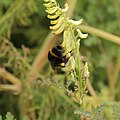Top Qs
Timeline
Chat
Perspective
Corydalis
Genus of flowering plants in the poppy family From Wikipedia, the free encyclopedia
Remove ads
Corydalis (from Greek korydalís "crested lark") is a genus of about 540 species of annual and perennial herbaceous plants in the family Papaveraceae, native to the temperate Northern Hemisphere and the high mountains of tropical eastern Africa. They are most diverse in China and the Himalayas, with at least 357 species in China. Corydalis species are the only dicots having only a single cotyledon (seed leaf).[1]
Remove ads
Ecology
Corydalis species are used as food plants by the larvae of some Lepidoptera species (butterflies), especially the clouded Apollo.
Toxicity
Corydalis cava and some other tuberous species contain the alkaloid bulbocapnine, which is occasionally used in medicine but scientific evidence is lacking in the correct dosages and side effects.[2]
Many of the species in Corydalis contain other toxins and alkaloids like canadine, which blocks calcium. The species C. caseana is poisonous to livestock.[3]
Taxonomy
Summarize
Perspective
Current species
There are about 540 species, including:
- Corydalis ambigua
- Corydalis aurea
- Corydalis buschii
- Corydalis bracteata
- Corydalis cava
- Corydalis caseana
- Corydalis cheilanthifolia – ferny corydalis
- Corydalis chelidoniifolia
- Corydalis darwasica
- Corydalis elegans
- Corydalis filistipes
- Corydalis flavula
- Corydalis flexuosa
- Corydalis heterocarpa
- Corydalis incisa
- Corydalis integra
- Corydalis linstowiana
- Corydalis micrantha
- Corydalis nobilis
- Corydalis ochotensis
- Corydalis omeiana
- Corydalis orthoceras
- Corydalis palaestina[4]
- Corydalis pallida
- Corydalis pauciflora
- Corydalis pauciovulata
- Corydalis rutifolia
- Corydalis saxicola
- Corydalis scouleri
- Corydalis solida – fumewort
- Corydalis vittae
- Corydalis wilsonii
- Corydalis yanhusuo
- Photos of Corydalis species listed above
- Corydalis ambigua
- Golden smoke (Corydalis aurea)
- Corydalis buschii
- Corydalis bracteata
- Corydalis caseana
- Corydalis cava
- Ferny corydalis (Corydalis cheilanthifolia)
- Corydalis chelidoniifolia
- Corydalis flavula
- Corydalis flexuosa
- Corydalis heterocarpa
- Corydalis integra
- Corydalis linstowiana
- Corydalis nobilis
- Corydalis ochotensis
- Corydalis orthoceras
- Corydalis pallida var. tenuis
- Corydalis pauciflora
- Seed pods of Corydalis pauciovulata
- Corydalis rutifolia
- Corydalis scouleri
- Corydalis solida
- Corydalis vittae
- Corydalis wilsonii
Former species
Several former Corydalis have been moved to new genera:
- Corydalis lutea = Pseudofumaria lutea – yellow corydalis
- Corydalis ochroleuca = Pseudofumaria alba
- Corydalis sempervirens = Capnoides sempervirens
References
Wikiwand - on
Seamless Wikipedia browsing. On steroids.
Remove ads

























